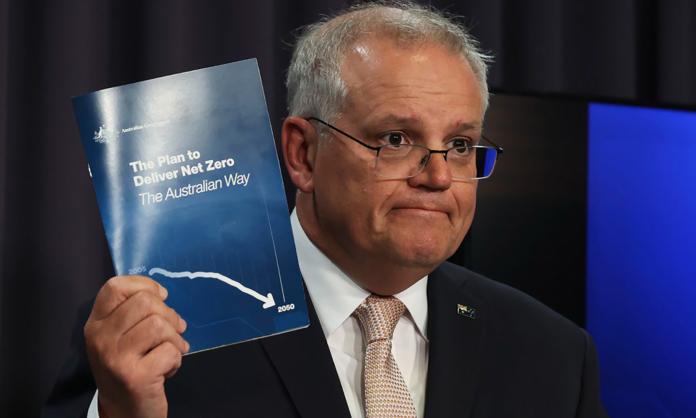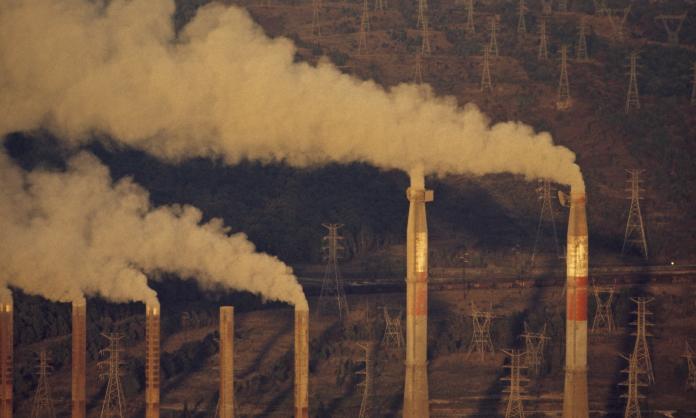No doubt Scott Morrison hoped he’d be granted a bit of a honeymoon by the whole “net zero by 2050” thing. Having dragged the Nationals kicking-and-screaming over the line and launched—on 26 October—Australia’s Long-Term Emissions Reduction Plan, he perhaps thought he could bask for a moment in the warm (green) glow of what was clearly meant to be viewed as a politically transformative moment for the government.
One might imagine the script in Morrison’s head running something like this: first, bring Australia into line with the fashionable “net zero by 2050” club; second, jet off to Glasgow—newly won green credentials in hand—to strut the world stage and hobnob with other, more established, members of the club; third, return to Australia with the air of a serious and responsible convert to the “green” economy; and fourth, kick-off an election campaign having neutralised one of the main potential lines of attack from his opposition.
Things, suffice to say, aren’t running according to script. The main stumbling block, aside from Morrison’s personal incapacity to come across as anything other than a buffoonish shill for the worst elements of Australia’s corporate elite, was the “net zero” plan itself. It was so transparently just an exercise in massaging the message, rather than delivering anything even vaguely resembling serious action on climate change, that putting a positive spin on it became a near impossible task, even for the government’s most determined media propagandists.
Some have tried, and no doubt that will continue in the coming weeks and months as we head towards the election. But it seems doubtful, at this point, whether anyone much beyond the absolute deepest-blue of “swing voters” in affluent urban electorates like Kooyong in Melbourne—people desperate for even the flimsiest excuse not to shift their vote from the traditional party of the ruling class to the Greens or “climate” independents—will be convinced.
If the plan was a dish it would be the left-over bolognaise that’s been slowly festering in a plastic container in the back of the fridge for a week—heated to lukewarm in the microwave and served with some Coles brand penne and a fresh sprig of parsley on the side. That single green sprig of parsley is the headline commitment to achieve “net zero by 2050”. Everything else remains exactly as before. And just as you’re unlikely to impress the friend or date you invite over with your half-warmed, week-old bolognaise, so too is it going to be tough for Morrison to sell a “net zero” plan that barely reheats the government’s existing, climate destroying policies.
Most telling is the fact that the plan contains no new, more ambitious 2030 emissions reductions targets. Despite offering an updated projection of Australia’s carbon emissions in 2030 of 35 percent below 2005 levels, Morrison refused to make this a formal goal, instead sticking with the government’s current commitment of a 26-28 percent reduction. His refusal to commit has good reason. As Ketan Joshi explained in an article in Renew Economy, the updated projection is (like so many of the government’s claims about its performance on climate) based on fiddling with the numbers rather than anything of actual substance.
The main purpose of the plan, of course, isn’t actually to reduce emissions, but merely (so Morrison and his big business backers hope) to give the government a bit more political license to let Australia’s fossil fuel economy continue on its highly profitable (for them) and highly destructive (for us) way for the foreseeable future. As Thom Woodroofe summed it up in the Guardian: “There are no new policies, no concrete pathways to get there, no cap on fossil fuels and no specifics. All the heavy lifting is either pinned on the hope of future technologies, or reliant on using carbon credits (effectively accounting tricks which do nothing for the planet)”.
In offering up his tragicomic non-plan, Morrison is, unfortunately, much more in line with the likes of US president Joe Biden than most progressives would want to admit. On a global level, the fad for making “net zero by 2050” commitments—one which has been embraced by many governments and increasing numbers of major corporations, including those in the business of fossil fuels—is more a means of greenwashing the status-quo than actually cutting emissions. When you look at the fine print of all these “net zero” plans you find the same heavy reliance on offsets, and same faith in (to date almost completely useless) technologies like “carbon capture and storage” to come to the rescue.
If we’re to avoid the devastation that will result from the failure of Morrison and other world leaders to act seriously on climate change, we need a genuine plan for rapid emissions cuts starting now. Even with the more “ambitious” targets being set by some countries in the lead-up to COP26, the world still has little hope of avoiding warming of 2 degrees Celsius or more by the end of the century. To keep warming to the 1.5 degree limit scientists regard as relatively safe requires much more drastic cuts, with rich countries like the US and Australia—the world’s biggest climate criminals—leading the way.
What might the plan we need look like? First, and most importantly, we should massively increase taxes on the rich and big corporations. The richest 250 Australians increased their collective wealth by $93 billion in the first year of the COVID-19 pandemic. None of them actually needed the extra money. The tax on that wealth increase should have been 100 percent. And why not take it further? Would Gina Rinehart be any less useful (or more appropriately: useless) if she was only worth $999 million? Would our society be irreparably damaged if Clive Palmer couldn’t afford to pour tens of millions of dollars into election campaigns anymore? Obviously not. Let’s really “make Australia great” by abolishing billionaires altogether.
Same for income above (very generously) $1 million a year. Why does anyone need more than that? They don’t, but society, and the environment it depends on, does. If you’re a high-flying banking executive you can keep $1 million of your exorbitant salary (for now)—but the rest will be taken away and put to good use. The world doesn’t need any more luxury yachts, private jets, or multi-million dollar holiday houses in Byron.
Alongside massive tax increases, we need strict restrictions on the movement of money across borders. If you’re Gina Rinehart or Clive Palmer and you want to take your money and run, then fine—you can leave with no more than $1 million. The rest stays with us. Same with all their mines and other assets. They should be taken over by the state and run in the public interest.
There should be no right for billionaires like Rinehart and Palmer to do whatever they want with their wealth. They didn’t “earn” all that money themselves through hard work. It’s doubtful whether either of them have done a genuinely hard day’s work in their lives—unless you count, in Rinehart’s case, the labour involved in writing extremely bad poetry or waging court battles against your own children over their inheritance. It was workers who created the wealth of Australia’s billionaire class and it’s them, and the society they live in, that should receive the lion’s share of the benefit from it.
With tax increases on this scale, as well as other measures like, for example, a massive cut to Australia’s bloated military budget of $45 billion, you’d have a very significant sum at your disposal for a genuine, rather than just rhetorical, greening of the economy (alongside other urgent measures such as more funding for healthcare, education and welfare, the large-scale construction of new public housing, and so on).
You could start by taking Australia’s coal and gas industries into public hands and beginning the process of shutting them down, while at the same time funding a rapid expansion of renewable energy. The limited amount of gas that might still be required as a back-up for renewables during the transition period could easily be offset by reforestation and other proven measures. And fossil fuel workers could be supported either to comfortably retire or to retrain for employment in the growing green economy.
You could roll out new green infrastructure on a massive scale. This would include things like constructing a high-speed rail network connecting major urban centres to reduce the need for air travel, massively expanding and improving public transport networks in cities, retrofitting existing buildings for higher energy efficiency and ensuring all new construction meets higher sustainability standards, and transitioning areas of the economy currently dependent on fossil fuels (such as transport, manufacturing and so on) to use electricity from renewables instead.
Over time, you’d transform many other aspects of our society that are destructive both to the environment and to human health and wellbeing. You’d radically redesign cities to reduce the distance people have to travel between their homes, workplaces and amenities. You’d restore degraded environments and create new forests and other green spaces both in urban areas and in the country. You’d employ the latest science on sustainable agriculture to shift away from the destructive “factory farming” model. In a context where the immense wealth that’s currently concentrated in the hands of the richest few was put at the disposal of society as a whole, the possibilities would be endless.
Unfortunately, of course, so long as it’s the Liberals or Labor in power, none of this is going to happen. When it comes to a clash between the interests of the rich and powerful, and the interests of society as a whole, the major parties can be depended on to prioritise the former. The most recent, and stark, example is the bi-partisan support for significant tax cuts for the wealthiest Australians.
In the vision of the future shared by both our prospective parties of government, rather than there being more funds available for spending on climate action or any of the other urgent challenges we face, there will likely be even more of a squeeze than there is today. Less for renewable energy and green infrastructure, less for public housing, healthcare, education and welfare, and less for basically everything else ordinary people depend on to live a decent life. And, on the other side, more in the pockets of the rich for those luxury yachts, private jets, and multi-million dollar holiday houses, and for all the other things that make their lives just one long, obscenely wasteful, indulgence.
Politicians don’t act in the interests of the rich and powerful just because they like them or are influenced by them personally (although no doubt both of those things play their part). They run things in this way because they’re committed to being effective managers of the capitalist system. And in capitalism it’s the ability for the rich to invest their wealth profitably, and become yet richer, that matters above everything else. Give-up on that, and you’re giving up on capitalism itself.
Any genuine plan to address climate change must, then, involve a break with the logic of capitalism. To undertake the kind of radical transformation we need in the timeframe necessary to avoid catastrophic levels of warming we have to turn the existing system on its head.
Instead of the economic and political structure of society being designed to ensure, above all, the continued flow of profits to the rich, we need a system that puts the wellbeing of society as a whole, and the health of the environment on which that wellbeing depends, first. We need a society based on cooperation rather than competition, on democratic planning rather than the anarchy of the market, and on the direct participation of the mass of workers who keep society running in all major decisions about what, and how, we produce.
The climate plan we need, in other words, is a plan for socialism. And it’s one that’s worth fighting for.











